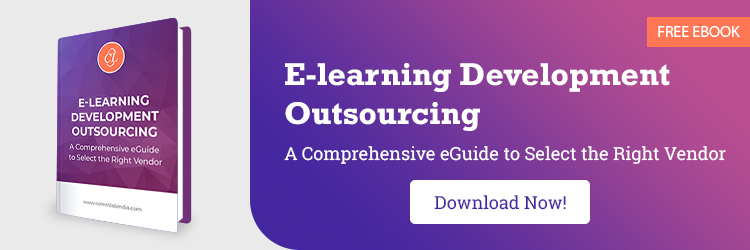In my previous blogs oneLearning outsourcing, we had discussed:
- Why you should outsource eLearning
- Potential problems with outsourcing and their solutions
- The prep work you should do before you outsource eLearning
- The tasks in eLearning development that can you actually outsource
That was about some of the ‘why’, the ‘how’ and the ‘what’ of outsourcing eLearning. But I’ve saved the best for last – how to make a business case for outsourcing eLearning. Because unless you can convince your management on the benefits of outsourcing eLearning, all this is really academic ‘nice-to-know’ information, isn’t it? We’ll also discuss how to choose the best vendor to outsource your eLearning.
So, let’s jump right in, shall we?
Making a Business Case for Outsourcing eLearning
Make a compelling business case for outsourcing eLearning by including these points in your presentation.
Build a winning eLearning business case with this guide.
Scalability without the Hassles
If you have a need to scale up training (for more learners or on different topics), you don’t have to worry about whether you have enough resources to do it, or if you can realistically meet the deadlines to launch the training – that is, if you outsource eLearning.
Outsourcing will help you ramp-up the design and development of eLearning on-demand, when you need it, according to your requirements. A capable vendor should be able to develop a large number of courses or convert thousands of传统课程, with quality and within timelines.
Making a Business Case for Outsourcing eLearning
What should you talk about?
- Scalability without hassles
- Increased productivity
- Improved quality at a lower cost
An experienced eLearning provider would also have an agile project management approach in place to ensure the entire process is streamlined. TheSuccessive Approximations Model (SAM)for eLearning development is agile, iterative, and flexible, and gives you the freedom to provide feedback to the vendor at any time during the process.
Increased Productivity
Outsourcing will give you access to eLearning experts who double up as ‘training consultants’ and help you understand the latest ‘trends’ – how they fit in with your training requirements and the optimal way to use them, rather than including them in your training kit just because everyone else seems to be doing it.
The vendor’s highly skilled and experienced instructional designers and tool experts will ensure the courses are more engaging, facilitating learning and improving results. Courses that provide more engagement and interaction mean higher completion rates and better learning, leading to increased productivity and enhanced training ROI.
Improved Quality at a Lower Cost
Outsourcing helps address the training needs of a constantly changing business environment while also keeping costs down. eLearning outsourcing may have higher upfront costs, but the reusability ofdigital assetsmakes it a viable and profitable proposition over time.
So, you’ve convinced your stakeholders to opt for outsourcing eLearning. The next step?
Choosing the right vendor!
Choosing the Best eLearning Development Vendor
It’s highly critical for the success of your eLearning outsourcing to choose the right vendor to take care of all your requirements. But, with so many eLearning design and development companies in the market, how do you do it?
Here’s a 5-point checklist to select the best eLearning vendor.
1. Experience, Expertise, and Reliability
Ensure the vendor can collaborate well with you, and has expertise in instructional design and custom eLearning development, and the ability to use technology. Check their website:
- If eLearning development is their core business. If it isn’t, this may not be the right fit.
- How long they have been in the eLearning business
- Their experience with eLearning in your domain
- Their thought leadership and customer education programs
- 他们的社会media – posts, promotions, views, and comments
2. Size & Scalability
It is essential to assess the size and scalability of the eLearning vendor.
- Check if the vendor can provide a dedicated team for your projects.
- Ensure that your vendor can ramp up to meet your growing requirements in the future.
- Check for their eLearning translation experience also.
3. Cost to Quality Ratio
While selecting the vendor, consider the ‘cost to quality’ ratio – the cost of your eLearning and the ROI. If you are clear about what you want from the project, comparing vendors in terms of cost (rate per learning hour of eLearning) and what they will deliver for it becomes a simple matter. This will help you narrow down your choice.
4. Samples of Similar Projects
Sample courses will give you a fair idea of their work and their capabilities in usingauthoring tools. Carefully assess their instructional design and project management skills, and if they match your requirements and objectives. Conduct a case study of their prior work, speak with other clients if available, and request a demo. Their previous work should give you an idea of the vendor’s capabilities.
5. Client Testimonials
The eLearning vendor may show you his best samples. So, a better way to assess them will be references from their clients. Check:
- If they had dedicated teams for projects
- If the team had problems understanding their eLearning requirements
- How they handled feedback and iterations
- Their ability to work across time zones and communicate effectively with stakeholders
Explore the trends in corporate training for 2022.
How Can You Ensure the Success of eLearning Outsourcing?
Working with a preferred eLearning outsourcing provider has several advantages, one of which is that the vendor knows your organization, your products, processes, and standards. This saves a great deal of time while also improving quality. But there are a few ways you can ensure your outsourcing is a success.
Make Time for Closing Meetings
Closure meetings are a type of audit at the end of the project on what went well and what did not during the project. Understanding what went wrong allows you to focus on the pain points. You can learn from these closure meetings to make your future initiatives smoother, building on the positives and rectifying the flaws.
Opt for a Master Service Agreement (MSA)
An MSA makes future project negotiations easier and faster for you and your eLearning vendor, as well as securing better pricing.
Conclusion
L&D departments are increasingly being tasked with developing effective training courses on tight budgets. Outsourcing eLearning design and development may help reduce total training development costs while also improving the quality of training, ultimately resulting in improved employee performance. It can be a one-stop solution to the challenges that firms have with developing eLearning in-house. Outsourcing also helps organizations to gain access to experts in instructional design and authoring tools.
如果你还有疑虑网络学习outsourcing, this free eBook will show you how to determine whether eLearning outsourcing is right for your training needs and how to make the most of it. It also offers practical advice on how to construct learner-centric courses within given parameters without compromising on quality.






![Pre-Work to Save Time when Outsourcing eLearning [Infographic]](http://www.vine9.com/wp-content/uploads/2020/03/elearning-outsourcing-pre-work.jpg)